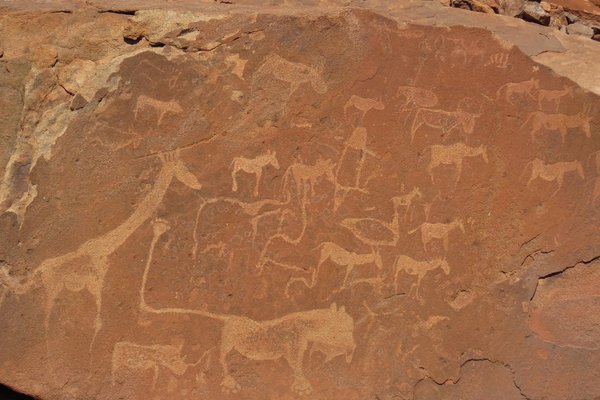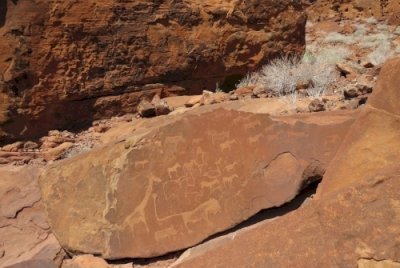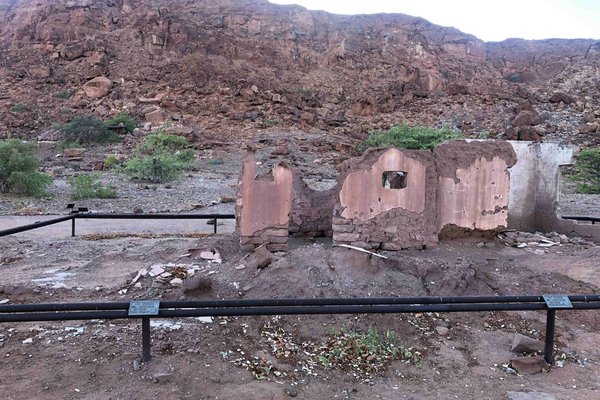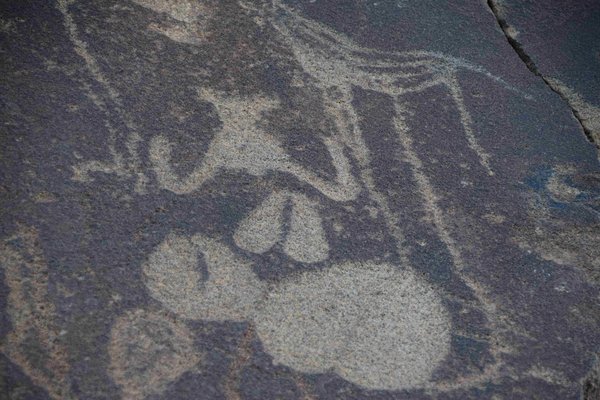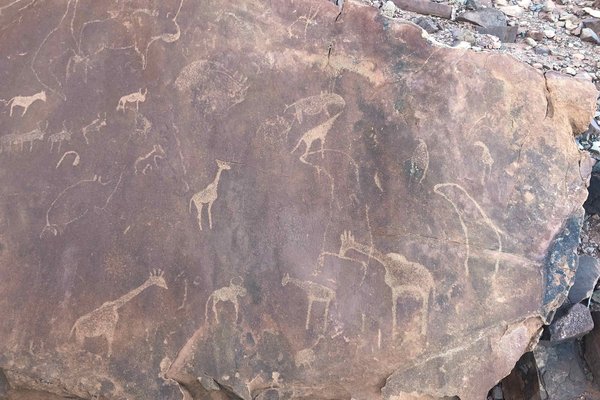Namibia
Twyfelfontein
Twyfelfontein or /Ui-//aes contains over 2,000 rock art figures that relate to ritual and economic practices by San hunter-gatherer communities.
The petroglyphs and pictographs were created over a couple of thousand years until the arrival of nomadic pastoralists. They depict rhinoceroses, elephants, ostriches and giraffes as well as human and animal footprints. Their locations are related to reliable water sources.
Community Perspective: Although it lies deep in a barren valley, it sees a fair number of visitors and facilities are adequate. Els did the Lion Man circular trail with a guide and stayed overnight in the controversial Twyfelfontein Country Lodge.
Site Info
Official Information
- Full Name
- Twyfelfontein or /Ui-//aes (ID: 1255)
- Country
- Namibia
- Status
-
Inscribed 2007
Site history
History of Twyfelfontein
- 2007: Inscribed
- Inscribed
- Type
- Cultural
- Criteria
- iii
- v
Links
- UNESCO
- whc.unesco.org
- Related
-
- africanworldheritagesites.org — African World Heritage Sites
All Links
UNESCO.org
- whc.unesco.org — whc.unesco.org/
Related Resources
- africanworldheritagesites.org — African World Heritage Sites
News Article
- July 27, 2007 allafrica.com — Namibia: Twyfelfontein Now a 'World Heritage Site'
Community Information
- Community Category
- Archaeological site: Rock Art
Travel Information
Guided Tour Only
Most Remote Cultural WHS
Recent Connections
-
Perfect Inscriptions
2007 -
Most Remote Cultural WHS
About 6h drive from Windhoek -
Dual WHS names
Twyfelfontein is Afrikaans and means un…
Connections of Twyfelfontein
- Ecology
-
-
Ratites
common ostrich
-
- World Heritage Process
-
-
Perfect Inscriptions
2007 -
First inscriptions
Namibia (2007)
-
- Human Activity
-
-
Hunter-gatherers
The site forms a coherent, extensive and high-quality record of ritual practices relating to hunter-gatherer communities in this part of southern Africa over at least 2,000 years, and eloquently illustrates the links between the ritual and economic practices of hunter-gatherers. (official description) -
San
"All the rock engravings and rock paintings within the core area are without doubt the authentic work of San hunter-gatherers who lived in the region long before the influx of Damara herders and European colonists" (AB ev) -
Pictographs
There are six shelters with painted images (AB ev) -
Petrosomatoglyphs
Hand and footprints -
Petroglyphs
-
- Constructions
-
-
Purpose Built Visitor Centre
2005, Core Zone "Designed in accordance with the Burra Charter (ICOMOS rev 1999) to have the least possible physical and aesthetic impact and to be reversible" (Nom File)See sbd2050.org
-
- WHS on Other Lists
-
-
U.S. Ambassadors Fund
Documentation of Granite Kop Rock Art (2005), Preservation of Stone Age Rock Art Paintings at Twyfelfontein (2004)
-
- Timeline
-
-
Built in the 4th millennium BC
Oldest findings date from 5,850 BP
-
- Visiting conditions
-
-
Foreigner prices
Foreigners pay 100 NAM dollar, locals 50 -
Guided Tour Only
You get assigned a guide at the visitor center. -
Most Remote Cultural WHS
About 6h drive from Windhoek
-
- WHS Names
-
-
Dual WHS names
Twyfelfontein is Afrikaans and means uncertain spring). ǀUi-ǁAis is Damara/Nama and means jumping waterhole. Different but similar, which may be attributed to exoticizing of indigenous languages.
-
News
- allafrica.com 07/27/2007
- Namibia: Twyfelfontein Now a 'Worl…
Recent Visitors
Visitors of Twyfelfontein
- AC
- Alexander Barabanov
- alicemears
- AmyAbroad
- amychemu
- Atila Ege
- bergecn
- Bernard Joseph Esposo Guerrero
- Bill Maurmann
- Bram de Bruin
- brornt
- Claire Bradshaw
- Colossus
- Cyberczar
- Elf21
- Els Slots
- Emili Xaus
- Erik Jelinek
- Felicité
- Fernweh
- Gary Arndt
- Geert Luiken
- Gernot
- Harald T.
- Harry Mitsidis
- H Beswick
- Iain Jackson
- Jacob Otten
- janameerman
- Javier Coro
- Jawnbeary
- Jean Lecaillon
- Jon Eshuijs
- Kbecq
- Krijn
- Loic Pedras
- Lucio
- Ludvan
- Luis Filipe Gaspar
- Lukasz Palczewski
- lynnz317@aol.com
- Maja
- marcel staron
- Marlies van Wolfswinkel
- MAURO PODDA PANI
- Mikko
- Monica66
- MoPython
- Mozzer76
- Mtlmr
- Niall Sclater
- Nicole Lampos
- Nihal Ege
- Philipp Leu
- Pieter Dijkshoorn
- Piotr Wasil
- Randi Thomsen
- Reisedachs
- Roger Ourset
- Rosemary
- Sandra!
- Stanislaw Warwas
- SteveD92
- Sutul
- Svein Elias
- Tamara Ratz
- Tatiana Nikulnikova
- Thomas Buechler
- Thomas van der Walt
- Timothy C Easton
- tony0001
- Vanessa Buechler
- Waxwing
- yasdeb
- Zizmondka
- Zoë Sheng
- Zsuzsanna Forray
Community Reviews
Show full reviews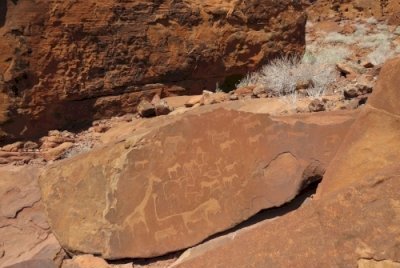
Twyfelfontein or /Ui-//aes is a rock engraving site in northern Namibia, supposedly the best of its kind in variation and number in Africa below the Equator. My non-Dutch trip mates had already great difficulty in pronouncing ‘Twyfelfontein’ (which is a perfectly normal word in Afrikaans and Dutch, meaning ‘doubtful fountain’). But try its alternative name ‘/Ui-//aes’: the slashes represent two different clicks in the local Damara language.
The site lies deep into a barren valley, surrounded by pretty rock formations made out of sandstone. All of a sudden you’ll end up at a car park and a visitor center – Twyfelfontein caters to 40,000 visitors a year so things are organized quite well. It conveniently lies on the route between Etosha and Swakopmund, and as there is not a lot else to see in the area many tour operators schedule stops here.
We are assigned a guide and after a short walk on the main road in the burning heat, we start our tour at the remains of the house of David Levin. He was a white farmer who settled in the area in 1946 to start a sheep farm. He was the one who named the site ‘Twyfelfontein’, and up against the rocks this unreliable but still delivering water source can be seen under a shelter. He showed the rock art to an archaeologist, and in 1952 Twyfelfontein already was protected as a monument.
The area is covered by two guided circular walks, the Lion Man …
Keep reading 0 comments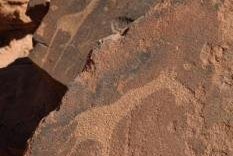
Twyfelfontein ("uncertain spring") got its name mid 20th century from a farmer who was in doubt whether his spring would provide sufficient water for farming.
It is famous for a large number of ancient (4.000-500 years BC) rock carvings depicting various types of (mostly) animals - even sea creatures. Contrary to the nearby Brandberg TWHS, it concerns rock carvings and not rock paintings. One can clearly distinguish the different animals in a fantastic setting of orange rocks.
To get there, you will need to drive 25km of Namibian 'D-road' (smaller gravel roads). When we visited the site, this road was quite bad but certainly doable, even without a 4x4. The carvings can only visited by guided tour but given the limited amount of tourists, we had a guide for ourselves. The route contains some uneven terrain / very mild climbing but should not be a problem for a normally fit person. However, it can get hot so make sure to bring a hat & water.
Keep reading 0 comments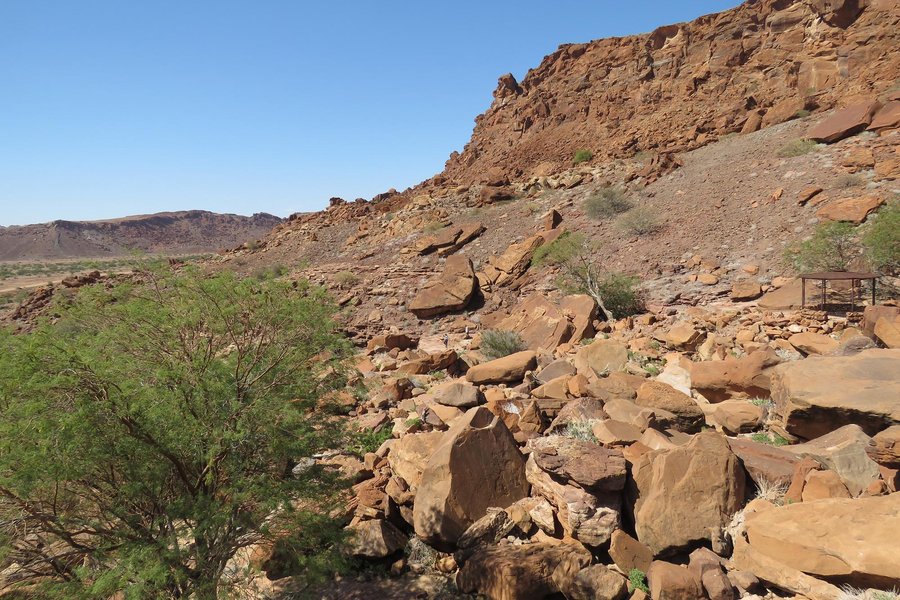
On my first ever visit to Twyfelfontein i was amazed with all the various rock formation and the arid desert surviving mopane trees.
I thought for a time this is one of the best scene perfect for movie making.
Have you ever imagine how the ancesters would dwell round in those boulders, man busy with rock art women with beads and children enjoying the perfect hot spring.
Taking your imagination futher what about the Jurassic age how green would have been there.
I was astonist to get all abovemention ideas running through my mind.
When i realize that the art left behind is for us to interprete and enjoy.Well there is all kinds of interpretation to the art as the academic ,scholars ,locas, visitors who so ever can just came and express what they see and leave every thing as it is for the next generations to enjoy.
Well for the youth as the future leaders let us try to penetrate the science of archaelogy.
Keep reading 0 comments
Twyfelfontein is not just a mega of rock arts(Engraving) its a holyritualg round of the hunter gathers who lived during that time.The side was use for various reason as a initiation place,ritual cermonies would take place there as the area is encave and the anscetral spirits would be kept in the enclosure for trance rituals take be more successfull compare to the surrounding.The side manifest the realm of african wisdom and way of cultural recording this shows us the different way of communication our anscester had.Young boys will be teach the diffent kinds of animals found in the area,their foodprint and it will be added with oral history about the hunding and gathering methods of the specific community.For me there is no clear tourism policy to controll tourism in the area and this may in the future have negative impacct on the rock art and the lanscape.
Keep reading 0 comments
Twyfelfontain is an impressive collection of rock carvings found on a hill in central Namibia. It was extremely hot on the day I visited and the climb in the beating sun (there is very little shade and it's steep) was tough. I would therefore recommend water, suncream, sunhat and visiting as early or late in the day as possible.
The carvings are incredible. Unlike some ancient rock paintings, it's very easy to distinguish which animals are which. Lots of iconic creatures feature, including an elephant, giraffes, ostrichs, a lion and gemsbok. Some of these are no longer found in the immediate area around the hills, and there is also an image of a seal which indicates the people had access to the coast, a long way off.
The site is not very developed and was fairly quiet when we visited. There were no signs of degradation or abuse and we were guided at all times by a well informed guide. Given its out of the way location I assume visitor numbers are probably still low compared to many World Heritage Sites. I found it worthwhile visiting, although I wouldn't go to Namibia solely to see this. Combined with the Skeleton Coast, desert, or a safari though it is worth a look.
Keep reading 0 comments
